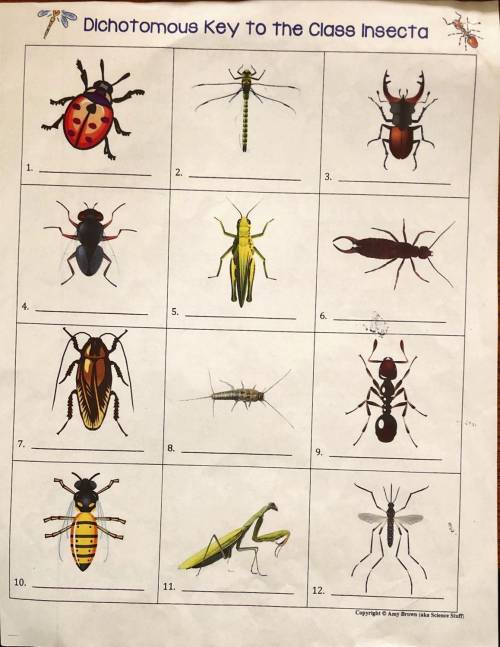
Chemistry, 23.01.2021 23:40 fortwill05
Dichotomous key to the Class “Insecta”
1A. Insect has wings that extend outward from the body-Go to 2
B. Insect has wings folded tightly against abdomen or no wings-Go to 5
2A. Insect has one pair of wings-Go to 3
B. Insect has two pairs of wings-Cordulla aenea
3A. Legs are longer than body-Tipula abdominalis
B. Legs are shorter than body-Go to 4
4A. Insect has rounded abdomen-Musca Domestica
B. Insect has sharp, pointed abdomen-Vespula squamosa
5A. Wings are folded over abdomen-Go to 8
B. No wings are present-Go to 6
6A. Abdominal appendages are present-Go to 7
B. Abdominal appendages are absent-Tapinoma sessile
7A. Abdominal pincers are present-Forticula Auricularia
B. Three abdominal appendages are present-Lepsima saccharina
8A. Antennae much shorter than body length-Go to 9
B. Antennae as long as body-Blattella vaga
9A. Pincers present on head region-Lucanus capreolus
B. No pincers present on head-Go to 10
10A. Large and rounded abdomen-Coccinella septempuntata
B. Long and slender abdomen-Go to 11
11A. Front legs are adapted for grasping-Mantis religiosa
B. Front legs are adapted for walking-Stethophyma gracile


Answers: 1


Other questions on the subject: Chemistry

Chemistry, 21.06.2019 17:30, kev71
You are performing an experiment in a lab to attempt a new method of producing pure elements from compounds. the only problem is that you do not know what element will form. by your previous calculations you know that you will have 6.3 moles of product. when it is complete, you weigh it and determine you have 604.4 grams. what element have you produced?
Answers: 1

Chemistry, 22.06.2019 03:30, asianaenaeh
Select the correct answer. when carbon dioxide dissolves in water, it sometimes reacts with water to form carbonic acid as in this balanced equation: co2 + h2o → h2co3. if 495 milliliters of carbon dioxide at 25°c and 101.3 kilopascals reacts with excess water, what is the theoretical yield of carbonic acid? use the periodic table and the ideal gas resource a. 0.889 g b. 1.10g c. 1.27g d. 2.02g what's the answer! quick!
Answers: 1

Chemistry, 22.06.2019 20:00, jalenevoyles
Phosphoric acid is a triprotic acid ( =6.9×10−3 , =6.2×10−8 , and =4.8×10−13 ). to find the ph of a buffer composed of h2po−4(aq) and hpo2−4(aq) , which p value should be used in the henderson–hasselbalch equation? p k a1 = 2.16 p k a2 = 7.21 p k a3 = 12.32 calculate the ph of a buffer solution obtained by dissolving 18.0 18.0 g of kh2po4(s) kh 2 po 4 ( s ) and 33.0 33.0 g of na2hpo4(s) na 2 hpo 4 ( s ) in water and then diluting to 1.00 l.
Answers: 3
You know the right answer?
Dichotomous key to the Class “Insecta”
1A. Insect has wings that extend outward from the body-Go to...
Questions in other subjects:





English, 08.03.2020 08:28


Mathematics, 08.03.2020 08:29



Mathematics, 08.03.2020 08:31



